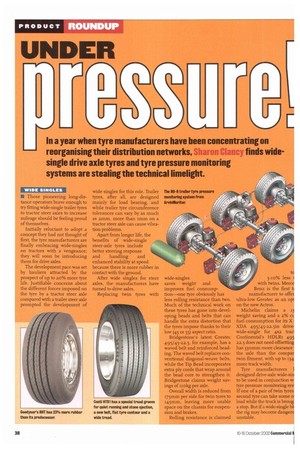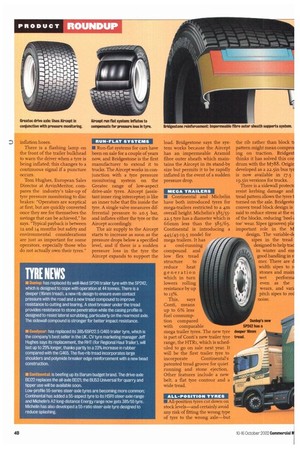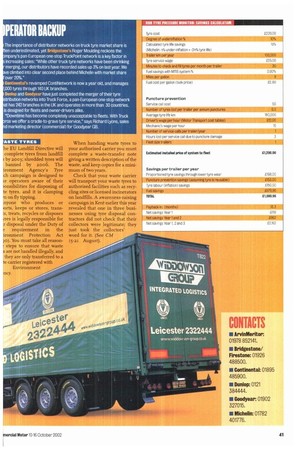UNDER
Page 38

Page 39

Page 40

Page 41

If you've noticed an error in this article please click here to report it so we can fix it.
In i
In a year when tyre manufacturers have been concentrating on
_
reorganising their distribution networks, haron Clancy finds wide single drive axle tyres and tyre pressure monitoring systems are stealing the technical limelight.
WIDE SINGLES
• Those pioneering long-distance operators brave enough to try fitting wide-single trailer tyres to tractor steer axles to increase mileage should be feeling proud of themselves.
Initially reluctant to adopt a concept they had not thought of first, the tyre manufacturers are finally embracing wide-singles on tractors with a vengeance; they will soon be introducing them for drive axles.
The development pace was set by hauliers attracted by the prospect of up to zo% more tyre life. Justifiable concerns about the different forces imposed on the tyre by a tractor steer axle compared with a trailer steer axle prompted the development of wide singles for this role. Trailer tyres, after all, are designed mainly for load bearing, and while trailer tyre circumference tolerances can vary by as much as 2mm, more than imm on a tractor steer axle can cause vibration problems.
Apart from longer life, the benefits of wide-single steer-axle tyres include better steering response and handling and enhanced stability at speed because there is more rubber in contact with the ground.
After wide singles for steer axles, the manufacturers have turned to drive axles.
Replacing twin tyres with wide-singles
saves weight and improves fuel consumption—one tyre obviously has less rolling resistance than two. Much of the technical work on these tyres has gone into developing beads and belts that can handle the extra distortion that the tyres impose thanks to their low (45 or 55) aspect ratio.
Bridgestone's latest Greatec 495/45-22.5, for example, has a waved belt and reinforced beading. The waved belt replaces conventional diagonal-weave belts, while the Tip Bead incorporates extra ply cords that wrap around the bead core to strengthen it. Bridgestone claims weight savings of irokg per axle.
Overall width is reduced from i75rnm per side for twin tyres to 145mm, leaving more usable space on the chassis for suspension and brakes.
Rolling resistance is claimed
t( 5-ro% less with twins. Mera Benz is the first t manufacturer to offe ultra-low Greatec as an op on the new Actros.
Michelin claims a weight saving and a 2% c fuel consumption for its X XDA 495/45-22.5in drive wide-single for 4.X.2 trac Continental's HDLIii 49, 22.5 does not need offsettinE has 33otarn more clearance the axle than the compa, twin fitment, with up to 134 more track width.
Tyre manufacturers designed drive-axle wide-six to be used in conjunction v.. tyre pressure monitoring sy.E If one of a pair of twin tyres second tyre can take some c load while the truck is brouF a stop. But if a wide-single b: the rig may become danger( unstable.
2===
rhe majority of operators w that correct tyre pressures critical for maximising fuel gumption and tyre life, and ;crying casings for remouldBut tyre manufacturers say tractor tyres can typically be under-inflated with trailer s soft by up to 20%. So it's going wrong? It's one .g knowing what should be e—and another [eying it in :tice.
leally tyre ;sures uld be isted to the actual being led, and r should checked
the tyre Did. A cold with an ;inal inflation ;sure of 8.o bar psi) measured at :ambient warmsup 5-80°C on a long run, which m increases the pressure by z..o bar (22-3opsi). So check. lyre pressures after a long can give misleading read;.
rnder-inflation is the main )rit for increased fuel coniption and reduced tyre wear. inMeritor says a 22-tonne ie at 56mph absorbs 75hp. If rolling resistance increased 7.5% that's another 5.6hp ig used simply to move the s, which translates into a 2% vase in fuel consumption. If one or two bogie tyres are ler-inflated, the remainder overloaded, A 5% overload aces tread life by 8%, says inMeritor, and increases fuel sumption by i%.
yre manufacturers have been king on pressure monitoring ems for truck tyres for over a ode, but devising a system : can recognise the difference N'een a pressure change sed by a slow puncture, a vier load or simply heat gened on a long run has proved a ky technical nut to crack.
he final development push, it ms, is the development of e-single drive and steer-aide 1.1
s on tractors.
ridgestone, Continental and elin have all announced syss this year, including in-tyre sensors, electronic control units and incab displays.
Michelin's Integrated Vehicle Tyre Monitoring (IVTM), developed in collaboration with Wabco, is due to be launched early next year following extensive trials on MANs.
The sensors on the wheels measure the inflation pressure several times a minute and transmit the result via radio signals. The ECU processes the data coming from each wheel. Trailers have a separate ECU which processes the readings from trailer tyre signals before relaying them to the main ECU.
The in-cab display gives the driver audio/visual warnings if pressure thresholds are exceeded or a leak is detected. The driver can confirm which tyre is causing the problem by pressing a button on the display. The ECU Can also calculate if a persistent pressure loss is being caused by a slow puncture so remedial action can be planned.
Michelin claims the system will pay for itself the first time an unscheduled tyre change is avoided.
TYRE INFLATORS
• One of the few tried and test tyre pressure inflation systems already on the market is the ROR Tyre Inflation System for trailers, marketed by ArivinMeritor. It is self-contained on the trailer, soil works regardless of the tracto type, and is maintenance-free.
Originally developed by U company EqualAir in the 19905, it is now owned by Pressure Systems International and sold exclusively by ArvinMeritor. The system monitors and maintains the tyres at their optimum coldtemperature pressure.
Air is taken from the air suspension feed and its pressure increased by a booster pump. The air passes through an air drier and pressure regulator to each of the three axle tubes and via hub-mounted rotary connections to each of the tyres. To ensure that any pressure loss is restored as quickly as possible, the air pressure in the axle tubes matches that in the tyres. The only moving part is the rotary union that links the hub to the
inflation hoses.
There is a flashing lamp on the front of the trailer bulkhead to warn the driver when a tyre is being inflated; this changes to a continuous signal if a puncture occurs.
Tom Hughes, European Sales Director at ArvinMeritor, compares the industry's take-up of tyre pressure monitoring to disc brakes: "Operators are sceptical at first, but are quickly converted once they see for themselves the savings that can be achieved," he says. "Typical payback is between 12 and 14 months but safety and environmental considerations are just as important for some operators, especially those who do not actually own their tyres."
RUN-PLAT SYSTEMS
• Run-flat systems for cars have been on sale for a couple of years now, and Bridgestone is the first manufacturer to extend it to trucks. The Aircept works in conjunction with a tyre pressure monitoring system on the Greatec range of low-aspect drive-axle tyres. Aircept (assistant inner ring interceptor) is like an inner tube that fits inside the tyre. A single valve measures differential pressure to to.5 bar, and inflates either the tyre or the Aircept accordingly.
The air supply to the Aircept starts to increase as soon as the pressure drops below a specified level, and if there is a sudden pressure loss in the tyre the Aircept expands to support the
load. Bridgestone says the system works because the Aircept has an impermeable Ararnid fibre outer sheath which maintains the Aircept in its stand-by size but permits it to be rapidly inflated in the event of a sudden pressure drop.
Continental and Michelin have both introduced tyres for mega-trailers restricted to a 4m overall height. Michelin's 385/5522.5 tyre has a diameter which is 66mni less than the 385/65. Continental is introducing a 445/45-19.5 model for mega trailers. It has a cool-running compound and low flex tread structure to
reduce heat generation which in turn lowers rolling resistance by up to 13%.
This, says Conti, means up to 6% less fuel consumption compared with comparable mega trailer tyres. The new tyre is part of Conti's new trailer tyre range, the HTRI, which is scheduled to go on sale next year. It will be the first trailer tyre to incorporate Continental's patented tread groove for quiet running and stone ejection. Other features include a new belt, a flat tyre contour and a wide tread.
ALL-POSITION TYRES
• All-position tyres cut down on stock levels—and certainly avoid any risk of fitting the wrong type of tyre to the wrong axle—but the rib rather than block ti pattern might mean comproi ing on traction. Bridgest thinks it has solved this cor drum with the M788. Origir developed as a 22.5in bus tyi is now available in 17.5 19.5in versions for trucks.
There is a sidewall protect( resist kerbing damage and tread pattern allows the tyres t turned on the ode. Bridgesto convex tread block design is said to reduce stress at the ec of the blocks, reducing 'heeltoe' wear. Sipes (grooves) pla: important role in the M design. The variable-d( sipes in the tread designed to help trac in winter and en: good handling in s mer. There are d width sipes to u stones and main wet performz even as the wears, and vani pitch sipes to rec noise.
ASTE TYKES
he EU Landfill Directive will complete tyres from landfill s by 2003; shredded tyres will banned by 2006. The ironment Agency's Tyre .ch campaign is designed to (e operators aware of their xinsibilities for disposing of te tyres. and it is clamping rn on fly tipping.
nyone who produces or orts, keeps or stores, transtreats, recycles or disposes yres is legally responsible for r disposal under the Duty of e requirement in the ironment Protection Act )o). You must take all reasonsteps to ensure that waste
s are not handled illegally, and they are only transferred to a te carrier registered with Environment ncy.
When handing waste tyres to your authorised carrier you must complete a waste-transfer note giving a written description of the waste, and keep copies for a minimum of two years.
Check that your waste carrier will transport your waste tyres to authorised facilities such as recycling sites or licensed incinerators on landfills. A awareness-raising campaign in Kent earlier this year revealed that one in three businesses using tyre disposal contractors did not check that their collectors were legitimate; they 101 just took the collectors' word for it. (See CM
15-21 August).




































































































































































